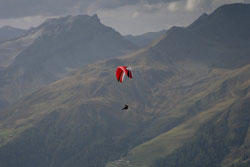| Home A B C D E F G H I J K L M N O P Q R S T U V W X Y Z |
|
Home |
Try Paragliding! A Quick Introduction, Plus an
|
|
|
|
Have you ever wondered about the basics of paragliding? Just how is a paraglider constructed? Or how do you actually fly one?
One of the first things you might notice about paragliders is that they look somewhat like sports parachutes. You know, when skydivers jump out of a plane at some big public event, pull their rip-cord to deploy the 'chute and then glide to earth. Sometimes with a colored smoke flare burning away the whole time, just to make it more spectacular.
While flying, a paraglider looks very much like a sports parachute. But paragliders are always inflated before the pilot leaves the ground, unlike sports parachutes.
When mountaineers first descended from their climbs by gliding off the hillside, decades ago, it was just a steerable parachute they were using. But getting off the mountain was tricky and not particularly safe. So began a process of development to make the steerable parachutes lighter, safer and better gliders. They became known as para-gliders, or paragliders.
Modern paragliders are wonders of aeronautical engineering in fabric and lines, and are remarkably safe and easy to fly. Even so, the basics of paragliding have remained much the same over many years. How paragliders work has barely changed at all.

Modern paragliders consist of 30 or more cells between an upper and a lower sail surface. Altogether, this is called the canopy. These cells are open at the front, so air rams in and keeps the wing inflated during flight. Connected to the underside of the canopy are a number of lines leading down to two or more risers which in turn are connected to the harness, above each shoulder of the pilot. A couple of brake toggles are connected to special steering lines as well. The pilot pulls on these to deform the wing a little so it steers left or right, as it glides down.
The lines supporting the pilot underneath the wing have received a lot of attention from designers. Modern materials are used which allow really thin and lightweight, but strong, lines. The lines are organized and connected together in such a way that there are many attachment points to the wing. This helps hold the shape of the wing and allows precise control. But there are only a few really long lines, which helps the paraglider slip through the air more easily.
That brightly colored paraglider you saw on TV the other night might have an L/D (lift to drag ratio) of 9 to 1, or 9:1. This means that if there was no wind and the pilot flew the wing at its best flying speed, it would gently glide down, travelling 9 meters across the ground for every 1 meter of height it lost. Or 9 feet to every foot of height lost, same thing.
Here's a comparison. If you make a little paper plane and toss it carefully across your living room carpet, it might manage 3:1 or so. The best I ever managed as a teenager was a paper plane design that got just over 5:1.
Now, how do you actually go about getting off the ground in one of these things? Quite easily, first comes the inflation phase. After you lay out your wing on the hillside, you face your wing with the wind on your back and pull on your A-risers. A-risers? They are connected to the lines that attach nearest the front edge of the wing.
So, after some guidance from an instructor, you get your wing filling with air and billowing up in the breeze.
Now what? Ok, you just start kiting your wing up and up. At this point it's behaving exactly as a kite. A huge, steerable one. Now it's overhead, in all its pressurized glory. You turn around, facing the breeze, a brake toggle in each hand, leaning into the wind and taking 1, 2, 3, wow, no more steps, you're off the ground!
Drifting a little to the left, so you pull down the right hand toggle just a tad. . . that's better, gliding straight down onto the beach now. As the sand gets really close, you pull down firmly on both toggles to slow the forward speed and descent rate of the paraglider, allowing a gentle drop at walking pace onto the sand.
Behind you, your wing deflates and flutters down in a heap. Time to pull it into a bundle and walk back up the sand dune for another ride! It was all quite easy, although getting the landings perfect can take a bit of practice. And this is just the start, a one-way 'sled ride' down to the sand. Paragliders can stay up in the air for a long time, in the right conditions, but that will have to be the subject of another article!
About The Author:
Tim Parish is a motorless flight enthusiast, the webmaster of http://www.paragliding-tales-and-reviews.com, a comprehensive
introductory site with an emphasis on humor. Tim has had the pleasure of soaring in sailplanes, hang-gliders and
paragliders in the past, both real and simulated. His enthusiasm for these activities is evident in his writing, which he
hopes will inspire others to fly.
|
Glossary References Links Contact
|